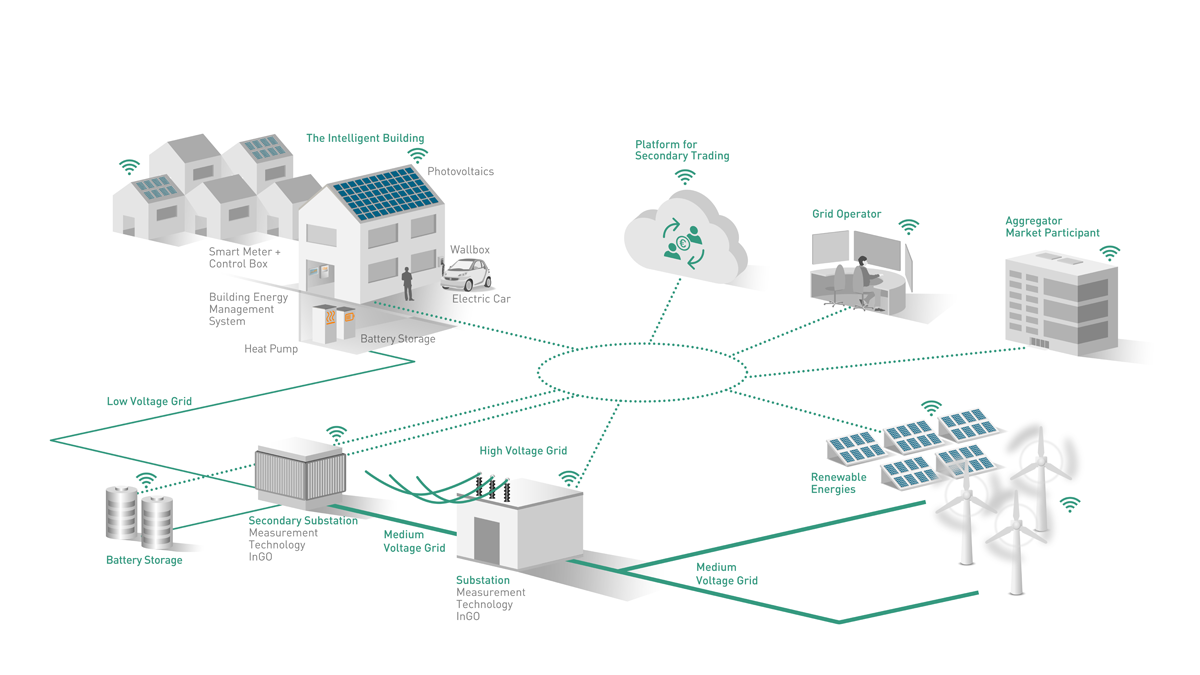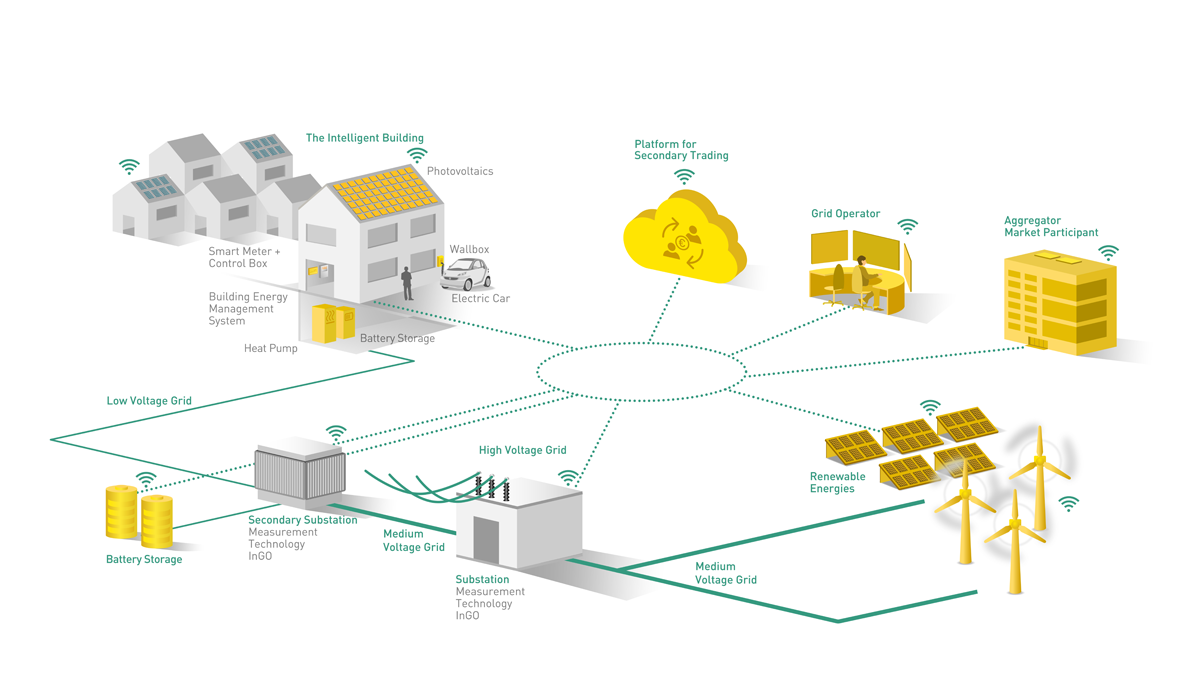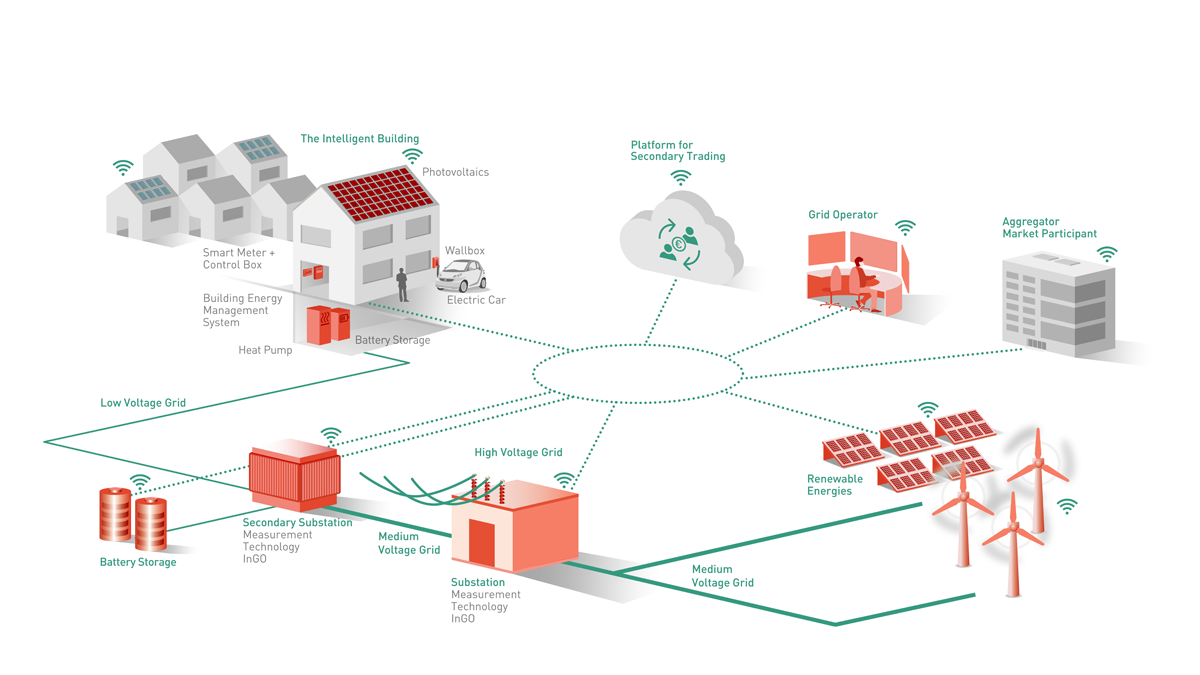Changes in the context of the energy transition, such as...
• Decrease of large power plants,
• Increase in decentral generation units (for example photovoltaics) &
• Increase in new consumers (for example electric cars and heat pumps),

• Decrease of large power plants,
• Increase in decentral generation units (for example photovoltaics) &
• Increase in new consumers (for example electric cars and heat pumps),
Distribution grids, which were previously only passive and distributed electricity from the large power plants to households, are becoming increasingly active. There are already areas where more electricity is generated than consumed at certain times. On some days, the distribution grid cannot transport all of the renewable-generated electricity. This poses the following risks:
• Grid congestions (without further measures, lines or transformers are overloaded)
• Regulation of decentralized units (supply of renewable energy is not fully utilized)
Our goal is to avoid these risks.
We are working on intelligent solutions with which power generation and power consumption can already be balanced locally, resulting in fewer grid congestions. The coordination of generation Units and consumers holds enormous potential for ensuring stable grid operation. To exploit this potential, the Units must be able to adapt or be flexible according to the situation in the power grid.
Optimal use and coordination of these flexibilities poses challenges for the grid operator, the solution to which we are developing in the flexQgrid project. Our approach to dealing with this is the so-called grid traffic light.
The grid traffic light is used as a control instrument for the targeted use of flexibilities. The grid traffic light makes the grid status transparent for grid operators, market participants and customers. In concrete terms, this means that units are intelligently coordinated and, in times of congestion, controlled in a demand-oriented and automated manner in order to guarantee grid security - and thus also security of supply. In developing our solutions, we also rely on the exchange with our colleagues from grid operationto support them in their increasingly complex tasks.
With the use of the grid traffic light, flexQgrid builds on the content of its predecessor project grid-control and uses the findings to further design and optimize the three traffic light phases.

In most cases, the traffic light is green. All units can feed electricity into the grid or draw it from the grid without any problems. With the help of their energy management, customers can optimize power consumption according to their wishes and use as much renewable power as possible.
The green traffic light phase stands for a safe and unproblematic condition of the grid. This means that all units can be operated according to their desired schedule. However, despite a relaxed situation in Freiamt, there may be a congestion in the upstream grid. In this case, we plan to use flexibilities in the low- and medium-voltage grid to support higher grid levels. In this way, we help to ensure that Freiamt is not the only town to be reliably supplied with electricity.
The flexibilities are used in the form of an area power plant. For this purpose, the active and reactive power potential of the available flexibilities is aggregated. This is then visualized for grid operation . A call-off concept is also being developed so that the output of flexibilities can be called off in bundles to support the upstream grid.

When forecasts indicate a congestion in the grid for the near future, the traffic light jumps to yellow. Without further measures, there would be an overload of lines and transformers. To avoid this, the grid operator distributes framework conditions to all players in the affected grid area, which in our case are implemented via a so-called quota. The energy management system then distributes the load in the household according to the quota and the customer's wishes, without any noticeable disadvantages for the customer.
If the storage is already filled, the neighbors and their storage as well as Electric cars can be included. In the future, we want to implement this idea in the form of a local marketplace so that neighbors can support each other.
If the traffic light switches to yellow, a grid congestion is forecasted for the following day. This leaves sufficient time to coordinate the flexibilities in such a way that the grid is relieved and the expected congestion is avoided. For this purpose, we determine a quota that provides information on how critical the expected grid situation will be and to what extent the desired schedules must therefore be adjusted. For an optimal adjustment of the schedules in the interest of the customers, we are testing a secondary market for flexibility.
The quota is determined for defined clusters of the grid. It provides information about the share of installed flexibilities that can be used in this cluster so that no overload occurs in the grid. Two quotas are determined - one for generators and one for consumers.
On the secondary trading plattform, participants can freely trade their flexibilities among themselves. For example, storage operators receive a financial incentive to charge their storage units so that PV systems can feed in their full capacity and all participants benefit - a win-win situation in which we harness the maximum possible energy from renewable generation. And the grid wins, too. Because if the quota is met, the grid condition is stable. The integration and design of a secondary market for flexibility form a central component of the project.
The market is implemented with the help of a Blockchain technologyso that all transactions are carried out securely and transparently. In addition to the technical implementation, legal and regulatory framework conditions are examined. Incentives are identified that increase the attractiveness of participation in the secondary market.

Sometimes, however, not everything goes as planned. If a unit fails at short notice, a sudden congestion can occur. The traffic light then turns red. Now the systems give all connected households target values. They must adhere to these in order to eliminate the congestion and not overload the resources.
Component failures and short-term deviations from weather forecasts can cause units to behave differently than planned. This increases the risk of grid congestions. To ensure secure grid operation at all times, we directly control the flexibilities in this case and coordinate them in such a way that the grid state relaxes. Since the situations in the grid vary greatly, the large number of units makes it impossible to manually determine the optimal Units operation by hand. For this reason, we are testing an intelligent system that analyzes the grid state in real time and controls flexibilities automatically as soon as things get tight. This means we are prepared for all eventualities!
The Intelligent Grid Operator (PSIngo) takes over the automated control of the units. PSIngo monitors compliance with capacity and voltage limits. PSIngo can control and regulate systems in a targeted manner via control boxes. To ensure that the grid status and the processes in the grid remain transparent, flexQgrid involves the grid operation .

Private homes have already become smarter as part of the energy transition. Many of our customers now have photovoltaic systems, battery storage, heat pumps and charging facilities for electric vehicles. This makes for increasingly complex generation and consumption behavior in households.
The systems can be intelligently coordinated via a building energy management system and the schedules can be adapted to the grid capacity. For this reason, the quota is not specified for individual systems, but for the entire grid connection point of a household. This guarantees households the greatest possible flexibility with regard to customer requirements.